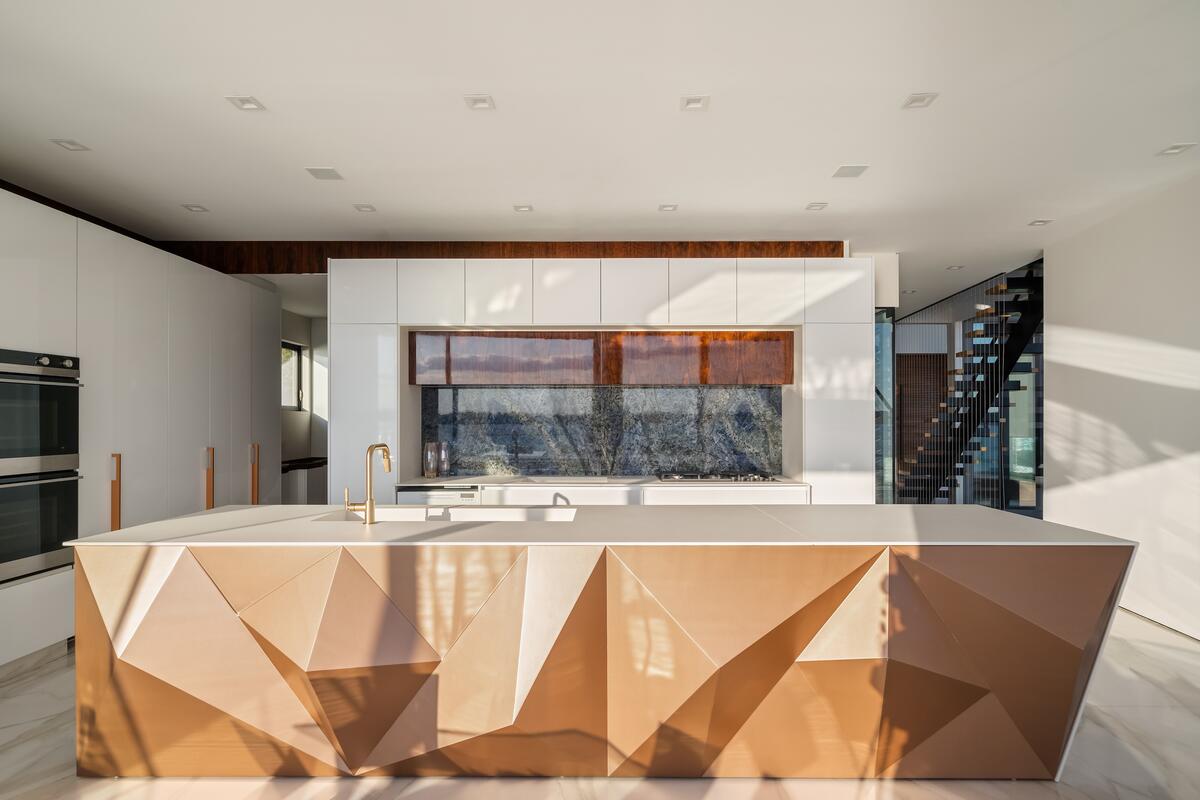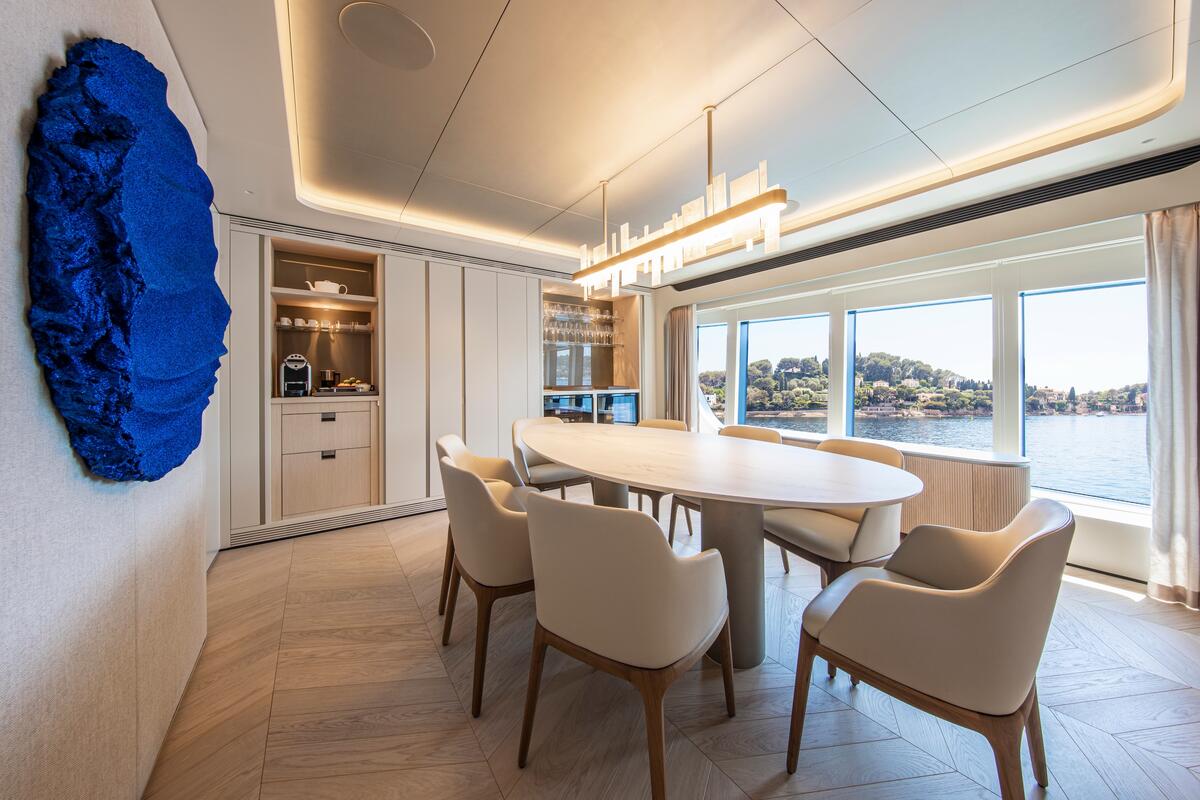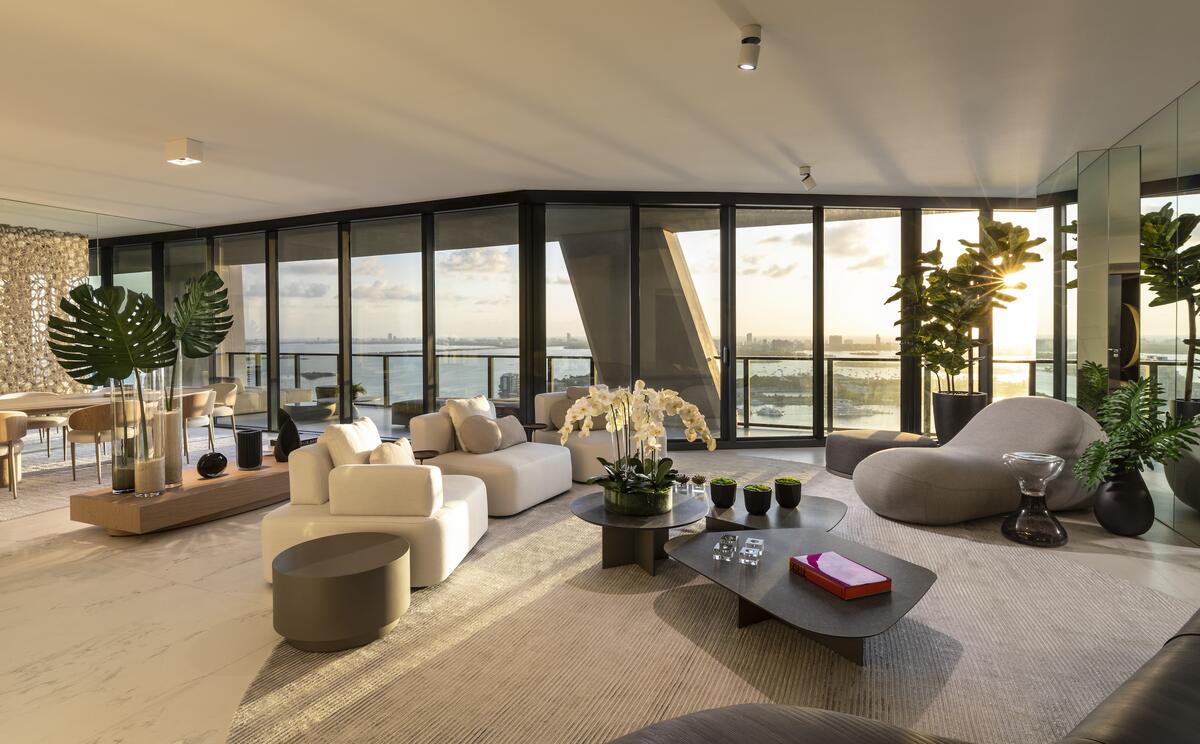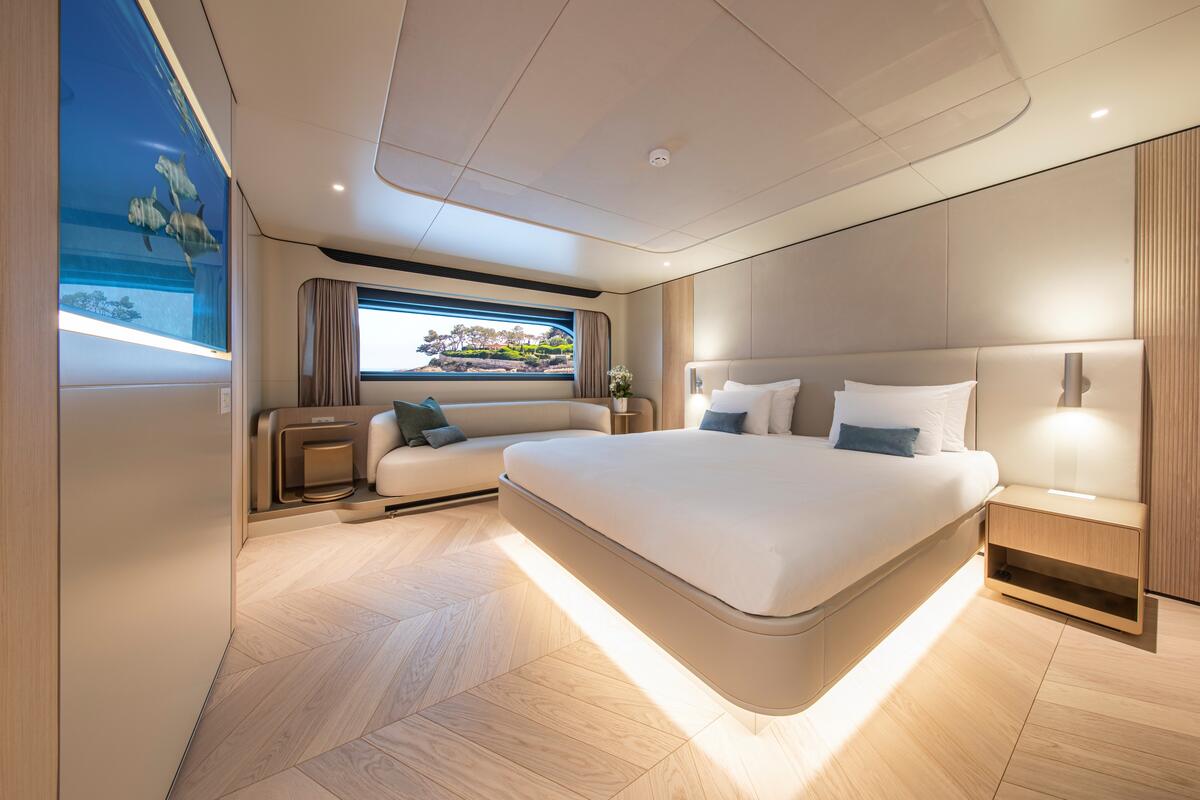The 50 States Project is a series of candid conversations with interior designers across the country about how they’ve built their businesses. This week, Miami-based designer Carla Guilhem tells us about expanding her business from residential to nautical interiors, how quiet luxury is permeating yachts, and how she keeps her passion for design alive.
What was your path to founding your own firm?
I studied architecture in Brazil. It’s a little bit different from the U.S., because the architecture and interiors [disciplines] are mixed together. That’s why the big architects in Brazil all do the interiors as well.
How did that education shape your experience?
After school, I moved from Brazil to Spain. That’s when I began to understand the difference, because Spain is like the U.S., where interiors and architecture [are separate]. While I was there, I decided to study interior design and product design—my focus was always on the interior, but also on the special pieces to [enhance] the design, and how to use materials like wood and stone. Spain has a very rich artisan culture, so I was able to go deep in this field.
I speak Italian, and I lived in Italy for a while, where I looked for courses in furniture and yacht design. I was always [learning] about interiors, but for more than just the house. Then I moved to New York. From the beginning, I worked for myself—I’m a free spirit, so it’s very hard for me to work for another person. For my first project, I had the chance to do a house in the Hamptons, [which led to] more and more high-end residential work. But I was always looking to create pieces in Brazil to bring to my projects in New York. Finally, in 2018, I decided to move to Miami.

Did you always know that you wanted to be an entrepreneur?
Yes. I don’t think anybody in my family is an employee—we all have this sensation to create, to do something new. I knew from the beginning how hard it is to build your business and run a company, but I never [considered] working at someone else’s studio. Never.
Actually, the U.S. is the best place to create a business. In Brazil, the bureaucracy is so hard. You’ll be working with lawyers for months to do everything. Here, there are incentives to incorporate, and people believe in you—there’s more trust, which allows your company to grow. Maybe it’s luck that I came here with this mentality, but I truly feel that. When I got my first client in the Hamptons, my English was not very good, and the construction [process] was completely different than my background because, of course, in the U.S., you build everything in wood and in inches. I had [to learn] all these [new skills], yet the clients believed in my talents and hired me. That’s different here too: Clients really want to create something different, and they’re looking to you to bring them something new or from another place.
After establishing your business in New York, what did it take to start over in Miami?
You need to find new suppliers and clients. It really is starting again. At the same time, for me, it’s always been more fluid in Miami—maybe because I speak Portuguese and Spanish. Yes, it was like starting from the beginning, but I had more speed in meeting people and building my network. I was getting out to meet all the real estate agents and developers.
And it was a nice moment to get here. The city is growing. Especially after Covid, so many people are moving to Miami. There’s a lot of work. My network [started with] Brazilian clients, and there are a lot of Brazilian people here, but I am also working with a lot of American clients from Boston, California, New York.

You also shifted your focus when you moved to Florida. How did you start designing yachts?
When I moved here, I was looking for yachts, yachts, yachts. I started going to boat shows to understand the interiors and how I can work within them. It’s the right place to be for it: A lot of yacht clients are here in Fort Lauderdale and West Palm Beach, and the market is very strong now because so many people bought a yacht during the pandemic. I was doing some staging and residential work when I got my first yacht client, who hired me to build a yacht completely from scratch. That was another world opening up to me, and I started to do more and more work on boats. Today, half of our work is residential interiors and condo developments, and half is yachts.
What was the learning curve like?
The good thing was that the first big boat I worked on was in collaboration with a design company in the Netherlands with 40 years of experience in the industry. It was during the pandemic, so other work was slow and I had time to study everything. But the interiors are so much more complex, because every millimeter inside of a boat counts. Everything is about storage. As a discipline, it’s much more of a mix of interior design, product design, architecture and engineering. You need to think about the comfort of the clients, but also safety, in that you cannot have sharp edges and you cannot use too much glass. You need to think about the durability of the materials. But at the same time, the yacht industry has amazing carpenters in the shipyards, so you know they will do exactly what you have designed.
I spent about one year learning, and then for the last few years, we have been growing the size of the yachts we work on and growing the team of people we work with. And we’re teaching the team inside our office as well, because there are not many professionals here in Miami who have this knowledge. It’s not a huge market, but if you are [willing to put in the time and learn the industry,] you can work a lot. Here in Florida, we’re seeing more and more people who need something for their boats.
Right now, the yachting industry is [in the process] of changing its design language, and I think that’s why we have been getting some of our new clients. The strongest shipyards in the world for big yachts are Dutch and German, but they still have this very strong and heavy design style. But here, we’ve started to do something that feels more residential—more calm, less about showing off. Clients are asking for something cozy, where they can enjoy nature. It’s not about the party boat; it’s about family.
What are you bringing to a project to make that shift?
We are trying to make these spaces more like a house. The general arrangements—what we call GAs, or the plan—were very copy-paste from one boat to another. You have the living area with a little sofa, on top of the sofa is the storage, and you have a table. Everything was the same. Now we are trying to eliminate that routine furniture and create more space to live in, inside and outside.
It’s also more calm. Just because you have a yacht, you don’t need to use 10 different marbles, you know? If there is less change in the materials, the design feels more like a house than a boat. We want these boats to feel like you’re at home, not in a Las Vegas hotel lobby.
I think it’s interesting how much that’s being driven by how people are using their boats differently. That’s a really meaningful change.
The yachting industry really grew during the pandemic because so many people were thinking, “Why don’t I buy a boat? Then I have space to go out.” The use was more for the family—and less for parties or just to show your clients that you have a yacht.
The U.S. market has also grown because Russian clients cannot buy yachts anymore. Russian sanctions have [prompted] the big yacht companies to look more to the U.S., and they’ve started showing more here to get more American clients while the Russian market is blocked.

What does your staff look like today? Do you have a separate team working on yachts?
There are 10 of us right now. For the shop drawings and technical documentation, yes, we have team members who specialize in yachts. But when it comes to accessories or decoration, the team that does interiors for residential can work on the yacht as well.
Where do you see opportunity for the business moving forward? Is it more in the yacht space, or is having a mix important?
I think it’s a mix, because the yacht owner has a residence—normally we do the yacht first and then we work on their home. We are also doing four [residential] buildings right now: one in Surfside, one in Bay Harbor, one in Palm Beach and one in Portugal. Those developments are another line of work that is going well here in South Florida, and I like that you can play around a little bit in the design of those common areas. Especially in the lobby, the developers usually want to do something very cool. This allows me to create everything—the space, the furniture, new ceilings and new walls. I’ve been [leaning into] those projects more and more.
That’s such a beautiful expression of your education, which really did blend all of those things.
Absolutely. I’m obsessed with lines, with materials, with details. It comes from starting with architecture. I start there, but then I go deeper and deeper, smaller and smaller. I like to go to exhibitions in Paris or Spain or Italy to see what they are doing with new materials. I think this is very important if you want to diversify, because you need to understand the ingredients to create something new.
What makes you say yes to a project today?
For residential, we are looking for big projects. Miami is very good for that—there are a lot of buildings coming up with amazing apartments, and the housing industry throughout South Florida is crazy. We want to take on a complete house from scratch, and it needs to be at least 4,000 square feet. We also want it to be more than just buying furniture, because we like to create some pieces or do something special—maybe a [custom] sofa or table. We need the type of client who appreciates that and wants something different. And for a yacht, I’d say we’re looking for a boat that is more than 30 meters.

How do you source for your projects?
We like the Italian stores, like Poliform or Minotti, because they have very good sofas. They’re very comfortable, and we know the quality. There’s an Artefacto showroom here, as well as a lot of great brands for exterior furniture that we use. But we also like to have a nice carpenter to do new work. We also work with some companies in Italy for custom accessories or tables in marble; there’s a company here in Miami called Casa Dio that creates different upholstered shapes for custom chairs that we design.
How do you approach billing for your work? And is it different for homes and boats?
I charge a flat fee. Beyond that, the only thing I charge for is the construction time and the visits that we do—that’s based on the duration of the construction. The rest is all by square feet or by the length of a boat.
What made you take that approach?
I have an understanding of how long a project will take, but I don’t like to charge by the hour. I work on Saturday or Sunday. Sometimes I’m designing something while I’m at the beach. And for me, it’s very hard to say, “Look, I was having brunch, and I got a new notebook and started to do your project.” Or, “I woke up at 3 o’clock in the morning and worked on your house until 6.” The time that I’m thinking [about work is not always] nine-to-five. It’s easier to say, “This is the price.”
And I don’t feel bad for charging. Maybe because it’s a creative profession, some people think, “Oh, she has a lot of ideas, and she can give me ideas.” But when you have a studio and payroll, you cannot give away ideas or lose time, because you have a lot of money to pay at the end of the month. My clients are all businessmen—they know the work is hard, and that you need money to pay for the work. And if I see that a project is getting bigger, or it’s going another way—that happens sometimes, where maybe the client just had another kid and wants to add another bedroom—then I can talk with them and say, “Look, this is not what we were expecting.”
We try to estimate [upfront] how long we will need for design, as well as the time for procurement or [creating] custom items. On a boat, we have a schedule that we need to follow—the shipyard gives us the timeline, and we have milestones that we need to hit with deliverables. With boat design, a lot of the work is documentation—that can take up to two months, because it’s a lot of plans. In the end, it’s like a book.
Residential work takes maybe one-third of the time to develop the plans—it’s much less than with a boat. But with the boat, the process is much longer in the beginning; once we send it to the shipyard, we just go to see how [the construction is progressing]. With houses, there are permits, or things that go wrong with construction. We try to condense the time, but sometimes it goes long, and then, of course, we need to adjust for that.

Are your clients asking you for more sustainable designs, and what do those conversations look like?
In the yacht world, it’s happening a lot. It’s an industry that takes a lot from the environment, so they are working hard to do something that’s for the environment. The shipyard and the clients are asking to use sustainable materials; on the engineering side, [they’re using more] hybrid motors and lighter materials, because the lighter it is, the less fuel you use.
If you don’t know materials, you cannot do much. As a designer, I think you need to be very on top of what is happening. It’s a challenge, but it’s part of the work. For example, it’s very hard to find a good teak, so we are doing a lot of research to find a company that does something that is close to teak but is not resin, which is not sustainable. Maybe it’s a bio-resin, or another type of wood that could work like a teak. Sometimes the material seems good, but it isn’t durable, or it’s too expensive. We do a lot of tests. For new fabrics, we do prototypes to see if it’s working or not. We’re working on an outdoor collection with a factory in Brazil, and we are always trying something new. They call me and say, “We found this bio-foam.” So we’ll try it in the sofa.
On the other hand, I feel that the design itself also needs to be sustainable: If I do a design that is so trendy today that you need to take everything out and put in everything new in two years, I can use the most sustainable materials in the world, but they are still being taken out and put in the trash. As a designer, being sustainable also means thinking about something more timeless, because that means the life will increase.

What does success look like for you?
I think success is when people recognize you for something that you do with passion, and you are paid to do it. If I do something but nobody buys it, I cannot keep doing it. But as more people want to pay for it and are happy with the results, that’s when I can see: Oh, it’s growing. It’s blooming. When you see that other people like what you are doing, that is when I feel it is going well.
I also like going to places I’ve never been before—I like to experiment, to speak another language, to learn about another field of my work. So I hope the future brings something new that I’m not expecting—maybe a spaceship, or big airplanes. Not jets, because those are small—something different. Right now, we are doing a project that is an explorer yacht. It’s so different from the normal motor yacht because it will receive scientists for part of the year and go to Antarctica, so the design approach for these spaces is completely different. It’s not a luxurious yacht, and I like that. It makes me research: What is this life? How do people enjoy this environment? How do people need to live in this space? That kind of learning is so important. Another of our projects was for a client in a wheelchair—how do you create wheelchair-friendly spaces that don’t feel like a hospital?
I don’t want to stop learning or be in a place where what I do is copy and paste, copy and paste. You can make more money doing that, but then you lose the passion.
To learn more about Carla Guilhem, visit her website or find her on Instagram.





























